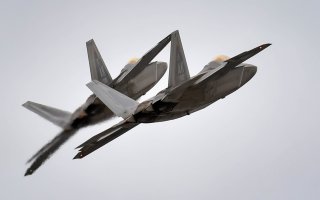What's the Difference Between a 5th or 6th Generation Fighter?
Today, there are four operational 5th generation fighter platforms in the world.
In 2005, the United States became the first nation on earth to field an operational 5th generation fighter in the Lockheed Martin F-22 Raptor. When you look at the F-22 compared to its 4th generation predecessors, the aircraft clearly stands out… but what exactly made it the first of a new generation, rather than a more advanced approach to the existing generation of fighters?
Generational designations often (or at least used to) come from within the aviation community itself. Each generation comes with a somewhat subjective list of capabilities that may have existed in some particular aircraft before, but become requirements across the board for fighters of the next generation.
Fighter generations are fairly subjective, so here’s how the Air Force broke down what new capabilities prompted a new generational designation:
-
1st Generation: Jet propulsion
-
2nd Generation: Swept wings, range-finding radar, and infrared-guided missiles
-
3rd Generation: Supersonic flight, pulse radar, and missiles that can engage opponents from beyond visual range
-
4th Generation and beyond: High levels of agility, some degree of sensor fusion, pulse-doppler radar, reduced radar signature, fly-by-wire, look down/shoot down missiles, and more.
Because new 4th generation fighters are still being produced, it is perhaps the muddiest of all fighter generations. As a result, 4th generation fighters are often further broken down into sub-generations such as 4, 4+, and 4++. These more advanced 4th generation platforms often boast some 5th generation capabilities, but not all.
In the case of the first 5th generation fighter, the F-22 Raptor, the most important thing differentiating it from its 4th generation counterparts was how stealth was an intrinsic part of the aircraft’s design. Rather than first designing a fighter for aerodynamics and performance and then seeking ways to reduce radar signature, F-22 development prioritized stealth from day one.
Of course, that wasn’t all that made the F-22 special, and although it was, in fact, the first actual stealth fighter on the planet, it also possessed several other essential 5th generation attributes. The F-22 came with highly integrated computer systems capable of communicating with other networked assets. It is a high-performance airframe capable of serving in a multi-role capacity. As a result, it maintains a higher degree of situational awareness than can be found in older platforms.
The F-22 also brought with it super-cruising capabilities — which means being able to sustain supersonic speeds without the use of its afterburner. For an intercept fighter like the F-22, the ability to super-cruise means being able to close with enemy aircraft at extremely high speeds while still saving enough fuel for the fight once they arrive. Conversely, the Air Force’s workhorse 4th generation multi-role fighter, the F-16 Fighting Falcon, will burn through all the fuel it has onboard within a matter of minutes with its afterburner ignited.
As a result, for some time, super-cruise capabilities were considered a part of what makes a 5th generation fighter a part of the 5th generation… That is until no other 5th generation fighter made it into the skies with that capability. Today, only the F-22 offers super-cruise capabilities within its generation, and as such, it’s become a valuable trait, but not a part of the generational distinction.
Today, there are four operational 5th generation fighter platforms in the world: America’s F-22 and F-35, China’s J-20, and Russia’s Su-57, flying alongside more than 25 different 4th generation platforms. Here’s a rundown of what, exactly, sets these four highly capable fighters apart from even the most modern and advanced 4th generation platforms like the F-15EX.
-
Stealth
-
A high degree of maneuverability
-
Advanced avionics systems
-
Multi-role capabilities
-
Network or data fusion capabilities
While some still debate the finer points of what’s required of a 5th generation fighter, these traits are commonly accepted. Some of these capabilities were present on 4th generation aircraft, but each must be present in a 5th generation platform. This begs the question then… what will be the criteria for a 6th generation fighter, when 5th generation platforms are still so rare?
Alex Hollings is a writer, dad, and Marine veteran who specializes in foreign policy and defense technology analysis. He holds a master’s degree in Communications from Southern New Hampshire University, as well as a bachelor’s degree in Corporate and Organizational Communications from Framingham State University.
This article first appeared on Sandboxx News.
Image: U.S. Air Force photo / Justin Connaher

